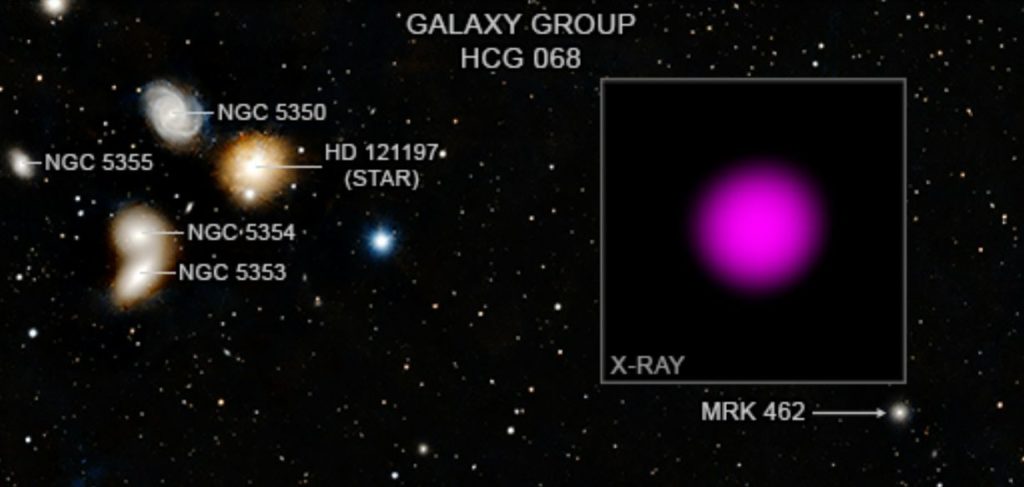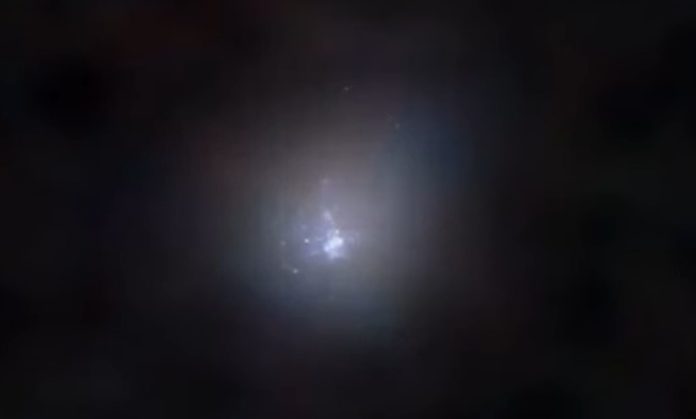The finding of a supermassive black hole in a tiny galaxy could help scientists solve the riddle of how the supermassive black holes form and grow.
The team used NASA’s Chandra X-ray Observatory to find a black hole in the galaxy Mrk 462, which has only a few hundred million stars and is turning into a dwarf galaxy, containing around 200,000 times the mass of the Sun buried in gas and dust.
By comparison, our Milky Way contains several hundred billion stars. This is one of the first times an “obscured” or heavily buried supermassive black hole has been discovered in a dwarf galaxy.
“This black hole in Mrk 462 is among the smallest of the supermassive, or monster, black holes,” says Jack Parker of Dartmouth College in New Hampshire, who led the study with colleague Ryan Hickox, also from Dartmouth. “Black holes like this are notoriously hard to find.”
Astronomers frequently discover black holes in larger galaxies by observing the fast motions of stars in galaxies’ centers. Dwarf galaxies, on the other hand, are too tiny and faint for most existing detectors to detect. Another method is to look for signs of expanding black holes, such as gas that has been cooked to millions of degrees and glows in X-rays as it descends towards one.
The team in this work used Chandra to examine eight dwarf galaxies that had previously exhibited signals of black hole formation in optical data collected by the Sloan Digital Sky Survey. Only Mrk 462 displayed the X-ray signature of a developing black hole among the eight.
The abnormally high intensity of high energy X-rays relative to low energy X-rays, as well as comparisons to data at other wavelengths, indicate that the Mrk 462 black hole is highly shrouded by gas.
“Because buried black holes are even harder to detect than exposed ones, finding this example might mean there are a lot more dwarf galaxies out there with similar black holes,” adds Hickox. “This is important because it could help address a major question in astrophysics: How did black holes get so big so early in the universe?”
Previous study has revealed that black holes can grow to a billion solar masses in less than a billion years, a fraction of the Universe’s present age. According to one theory, these gigantic objects were born when massive stars fell into black holes weighing only 100 times the mass of the sun.
Theoretical theory, on the other hand, struggles to explain how they might gain weight at such a rapid rate to reach the sizes found in the early cosmos.

Another possibility is that when the early Universe was formed, it was seeded with black holes with tens of thousands of solar masses, maybe as a result of the collapse of massive clouds of gas and dust.
If astronomers discover that a substantial percentage of dwarf galaxies contain supermassive black holes like Mrk 462, it supports the theory that little black hole seeds from the first generation of stars developed remarkably swiftly to produce the billion solar mass monsters in the early universe.
A lower fraction would tip the scales in favor of the theory that black holes started off weighing millions of Suns. This is because the conditions required for a direct collapse from a gigantic cloud to a medium-sized black hole should be uncommon, hence supermassive black holes are unlikely to be found in a substantial proportion of dwarf galaxies. In contrast, stellar-mass black holes are expected in every galaxy.
“We can’t make strong conclusions from one example, but this result should encourage much more extensive searches for buried black holes in dwarf galaxies,” said Parker. “We’re excited about what we might learn.”
These findings were supposed to be presented at the American Astronomical Society’s 239th meeting in Salt Lake City, but it was postponed owing to COVID-19 concerns.
Source: Chandra
Image Credit: NASA
You were reading: A heavily buried supermassive black hole found in dwarf galaxy may hold clues to giant’s growth
